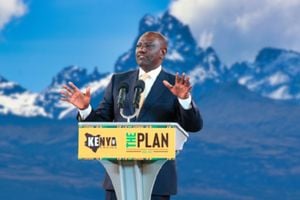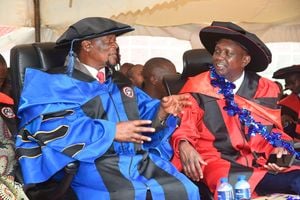Joy's renewable energy solutions

Her work aims to enhance the resilience and efficiency of renewable energy systems on the continent
What you need to know:
- The ride has not been easy at all but I keep showing up.
- When I left Kenya in 2022, I had no single strand of grey hair in my head but now I have the greys scattered all over my head.
Had 37-year-old Joy Atieno Adul lived up to her dad’s expectations, she would be a medical doctor today. “He believed I had the brain for medicine,” she shares. But medicine was never her thing - she freaks needles and has a dislike for medicines. Ms Adul pursued chemical engineering at Moi University, Eldoret, instead.
Years later, this decision led her to her current specialty in renewable energy. Currently, she is a doctoral researcher at Pennsylvania State University ((Penn State) where she is spearheading a project that models the impact of climate change on renewable energy generation in Africa, starting with Kenya.
Her work aims to enhance the resilience and efficiency of renewable energy systems on the continent, ensuring sustainable energy solutions in the face of climate variability.
Why renewable energy and why Africa?
Climate change is an emergency that transcends borders, and its impacts are unequally weighted against the world's most vulnerable, like the African continent. Climate variables such as temperature, wind speed, precipitation, relative humidity, and solar radiation significantly impact renewable energy generation. The paradigm shift in mitigating climate change is the decarbonization of the electricity sector by the widespread adoption of renewable energy. Therefore, as the world transitions to renewable energy sources, accurately estimating the variation of renewable energy generation for electricity supply under climate change is essential in reducing the uncertainty associated with a low-carbon and sustainable energy system.
How are you doing your research to ensure it is successful?
My research uses machine learning algorithms to characterize the climate sensitivity of renewable energy generation for electricity supply and predict future demand under a warming climate. I have built a model to predict renewable energy generation for electricity supply and project future generations under various climate change scenarios in California, New York, Georgia, and Florida. The research has already yielded significant insights that could be used by utility managers and decision-makers to improve their ability to predict renewable energy generation under a changing climate. Additionally, I believe understanding each state's unique challenges could help develop targeted adaptation and mitigation strategies.
Do you have partners in this journey?
Yes, a significant aspect of my research success is the collaboration with notable organizations, most prominently the Intergovernmental Panel on Climate Change (IPCC). This partnership not only enhances the scientific rigor of my work but also ensures that my findings and innovations are aligned with global standards and contribute to the broader understanding of climate impacts. My extensive professional background, spanning more than a decade with energy companies in East Africa, further amplifies the practical applications of my research. These experiences enable the development of tailored strategies that address specific regional challenges, fostering a more resilient and adaptable renewable energy infrastructure.
What exactly do you aim to achieve with this research?
My project is not just about modeling the impacts of climate change; it’s about creating actionable solutions that can be adopted across Africa. My work contributes to a more resilient and sustainable energy infrastructure, capable of withstanding the challenges posed by a changing climate. The goal is to provide a roadmap for African countries to develop robust renewable energy systems that can adapt to climate change. This is essential for ensuring energy security and supporting sustainable development across the continent. My vision includes the development of training programs and workshops for local engineers and policymakers, empowering them with the knowledge and tools needed to implement effective renewable energy solutions.
What are some of the challenges you have encountered in your journey?
Studying PhD in a foreign land with young children is not easy at all. I am a mother of two and when I relocated to the US to start my doctoral, my youngest was only 11 months old. When I left Kenya in 2022, I had no single strand of grey hair in my head but now I have the greys scattered all over my head. Also, prior to this, I had never experienced migraines but there was a point where migraines became part of my life and I used to pop painkillers every now and then. Academically, while I want to understand the impact of climate change on renewable energy generation, this data has been quite scarce in the context of Kenya and Africa at large. By analysing climate variables and their effects on renewable energy systems, we can develop strategies to enhance resilience and sustainability. But without the necessary statistics, this becomes a challenge to achieve.
Looking ahead, what are your goals for the future?
My immediate goal is to complete my PhD and continue contributing to cutting-edge research that drives the renewable energy sector forward. Long-term, I aspire to play a pivotal role in shaping energy policies and leading large-scale projects that not only advance technological innovation but also ensure equitable access to clean energy for all communities.
What’s your parting shot?
My research at Penn State is paving the way for a sustainable and resilient renewable energy future in Africa. By modeling the impacts of climate change, I am helping to secure a reliable energy supply for millions of people while also contributing to the global fight against climate change. My work exemplifies the extraordinary impact that dedicated research can have on addressing some of the world’s most pressing challenges. My commitment to sustainability and innovation is a beacon of hope for the future of renewable energy in Africa and beyond. Through my efforts, Africa can not only harness its renewable energy potential but also lead the way in creating a resilient and sustainable energy future for the world.





